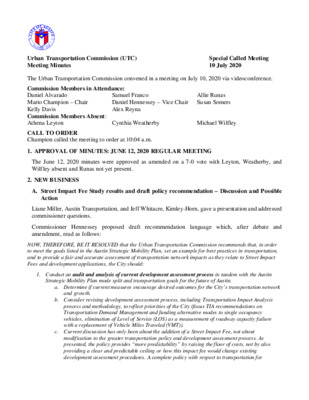Approved Minutes — original pdf
Approved Minutes

Urban Transportation Commission (UTC) Meeting Minutes Special Called Meeting 10 July 2020 The Urban Transportation Commission convened in a meeting on July 10, 2020 via videoconference. Commission Members in Attendance: Daniel Alvarado Mario Champion – Chair Kelly Davis Commission Members Absent: Athena Leyton Samuel Franco Daniel Hennessey – Vice Chair Alex Reyna Allie Runas Susan Somers Cynthia Weatherby Michael Wilfley CALL TO ORDER Champion called the meeting to order at 10:04 a.m. 1. APPROVAL OF MINUTES: JUNE 12, 2020 REGULAR MEETING The June 12, 2020 minutes were approved as amended on a 7-0 vote with Leyton, Weatherby, and Wilfley absent and Runas not yet present. 2. NEW BUSINESS Action A. Street Impact Fee Study results and draft policy recommendation – Discussion and Possible Liane Miller, Austin Transportation, and Jeff Whitacre, Kimley-Horn, gave a presentation and addressed commissioner questions. Commissioner Hennessey proposed draft recommendation language which, after debate and amendment, read as follows: NOW, THEREFORE, BE IT RESOLVED that the Urban Transportation Commission recommends that, in order to meet the goals listed in the Austin Strategic Mobility Plan, set an example for best practices in transportation, and to provide a fair and accurate assessment of transportation network impacts as they relate to Street Impact Fees and development applications, the City should: 1. Conduct an audit and analysis of current development assessment process in tandem with the Austin Strategic Mobility Plan mode split and transportation goals for the future of Austin. a. Determine if current measures encourage desired outcomes for the City’s transportation network and growth. b. Consider revising development assessment process, including Transportation Impact Analysis process and methodology, to reflect priorities of the City (focus TIA recommendations on Transportation Demand Management and funding alternative modes to single occupancy vehicles, elimination of Level of Service (LOS) as a measurement of roadway capacity failure with a replacement of Vehicle Miles Traveled (VMT)). c. Current discussion has only been about the addition of a Street Impact Fee, not about modification to the greater transportation policy and development assessment process. As presented, the policy provides “more predictability” by raising the floor of costs, not by also providing a clear and predictable ceiling or how this impact fee would change existing development assessment procedures. A complete policy with respect to transportation for development applications should be understood before the item is considered for approval by City Council. 2. Modify maximum street impact fees for all zones to be proportionate to the average VMT per vehicle trip originating or ending in the zone, or additional data collection and research as necessary. a. Ensure that zones that generate the most vehicle miles per person trip are charged proportionally to the impact imposed on the roadway network. This will incentivize development in low VMT- generating zones and/or zones that are able to accommodate proportionally more multimodal travel. b. Ensure that minimum and maximum fee reductions are calculated in an administrative manner. c. Emphasize the impact that parking has on vehicle trips to a project and incentivize the reduction of parking in future development. 3. Develop predictable and straightforward system such that developers will easily be able to determine the maximum amount their project is responsible for in advance. a. Consider creation of an online map with maximum impact fees per zone clearly listed. b. For formally going through the development assessment process, consider the creation of a Street Impact Fee Worksheet to be submitted with the TIA Determination Worksheet. 4. Create an online portal or status check to hold developers accountable for paying and to keep track of costs and expenditures for each zone. a. Allow developers to check the status of their application. b. Internal City of Austin page viewer to be used for keeping track of developments in each zone, projects that have been/are currently being funded, what percentage of funding is still needed, who has yet to pay Street Impact Fee, etc. 5. Consider methodology of trip generation, existing mode split consideration, and VMT per person-trip vs per vehicle-trip for new developments. a. First, determine the zone in which the project will be constructed in and the given land use. b. Calculate estimated vehicle trips using the Institute of Transportation Engineers (ITE) Trip Generation Manual. Use average number of person trips per vehicle trips for land use to determine entire expected entering and exiting trips from the site. c. Utilize American Community Survey (ACS) Census Data to determine existing mode split in project area. Apply to person trip generation to estimate the number of trips for each mode. d. Use (Average VMT Per Vehicle Trip Per Zone) x (Estimated Number of Vehicle Trips) = Total Estimated Daily VMT Impact on Roadway Network. A motion to approve the recommendation was adopted on an 8-0 vote with Leyton, Weatherby, and Wilfley absent. 3. STAFF AND COMMITTEE REPORTS No updates given due to time constraints. 4. FUTURE AGENDA ITEMS A. Austin Community Climate Plan update (Staff; August) B. Project Connect (Somers, Runas; August) C. Safe Mobility Bond (Champion, Alvarado; August) ADJOURNMENT Champion adjourned the meeting at 11:38 a.m. without objection.